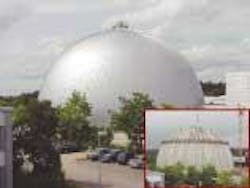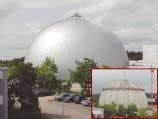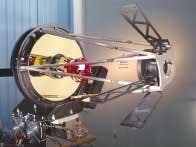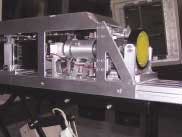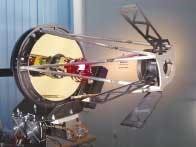Target simulator tests military IR sensors
In the past, when the German Armed Forces Research Establishment (Greding, Germany) wanted to test IR aircraft-tracking technology, it had to fly one or more military jets overhead as sample targets—an expensive proposition that limited tests to a few times a day at most. Now, however, the tests can be done at will in indoor comfort. The Target Simulation Facility, recently completed in Greding, consists of a 50-m-diameter concrete dome (a) that contains a precisely built hemispherical optical screen (b); inside, several visible and IR projection systems create a realistic landscape background on the screen and project moving IR targets onto the screen as well.
The prime contractor for the facility, E.sigma Systems (Munich, Germany), developed a 2400-square-meter screen surface with a high directional reflectivity in the visible and IR; the screen has a radius tolerance of less than 2 cm and a 100-metric-ton self-supporting steel construction for mounting the screen tiles. The screen material is made of metal micromirror elements mounted to hexagonal and pentagonal tiles. The screen has a reflectivity of greater than 99%; the angular reflectivity has a tophat shape, remaining constant to a 20° angle and dropping to less than 5% of that value at 30° and zero at 35°.
null
null
null
null
Twenty-seven 1280 × 1024-pixel projectors create a photorealistic background scene. The two-axis-motion (400°/s) target-projection system contains three different subsystems. A fixed-focus visual projector creates a daylight-quality visible computer-generated model of an aircraft superimposed on the landscape background; three variable-focus 10.6-µm laser-spot projectors overlay the IR "hot spots" characteristic of aircraft and missiles, simulating target temperatures of up to 1000°C at virtual 500-m target distances (c); and an IR-array projector generates a detailed target shape at wavelengths in the 3- to 5-µm range, with target temperatures of up to 100°C at virtual distances of 1000 m (d).
The sensor under test can weigh up to 60 kg and is mounted on a five-ton three-axis motion system that operates up to 1000°/s on the roll axis and 500°/s on the azimuth and elevation axes, and can accelerate to 40,000°/s2 in the roll axis. Sensors to be evaluated include fire-control and seeker systems for combat vehicles and missiles.
